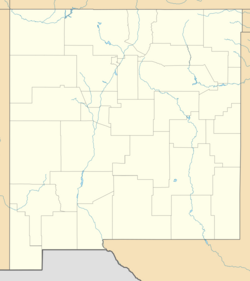Earth:Blackshare Formation
| Blackshare Formation Stratigraphic range: Miocene, 23–11.6 Ma | |
|---|---|
| Type | Formation |
| Unit of | Santa Fe Group |
| Underlies | Tuerto Formation |
| Overlies | Tanos Formation |
| Thickness | Over 1,260 m (4,130 ft) |
| Lithology | |
| Primary | Sandstone, conglomerate |
| Other | Mudstone |
| Location | |
| Coordinates | [ ⚑ ] 35°25′05″N 106°18′25″W / 35.418°N 106.307°W |
| Region | New Mexico |
| Country | |
| Type section | |
| Named for | Blackshare Ranch |
| Named by | S.D. Connell and S.M. Cather |
| Year defined | 2002 |
The Blackshare Formation is a geologic formation exposed in the Hagan Basin west of the Ortiz Mountains of New Mexico. It is estimated be to of Miocene age.[1][2][3]
Description
The Blackshare Formation consists primarily of sandstone and conglomerate with minor mudstone. The conglomerate forms lenticular bodies, with clasts consisting mostly of Ortiz porphyry with small amounts of hornfels and chert. The sandstone layers tends to be more coarse at their base. The dip of the beds (which is to the northeast) decreases from 16 degrees to 1 degree from the base to the top of the formation. Paleocurrents confirm deposition by stream flow from the Ortiz Mountains to the east. The total thickness is over 1,260 meters (4,130 ft).
The formation is divided into four informal members, described as a sandstone facies, a conglomeratic sandstone facies, a conglomerate facies, and a muddy sandstone facies. The formation interfingers with the underlying Tanos Formation and is overlain with angular unconformity by the Tuerto Formation.[1]
An ash bed about 200 meters (660 ft) below the top of the formation has a radiometric age of 11.65 ± 0.38 million years (Ma).[1]
The formation is interpreted as deposition by streams flowing from the east into a closed basin.[1] The progressive tilting of the beds, with the lower beds showing significant dip while the uppermost are nearly horizontal, may be connected to the uplift of the Sandia Mountains to the south while the sediments making up the formation were being deposited.[4]
History
The beds making up this formation were first assigned to the Santa Fe Formation by Stearns in 1953.[5] They were designated as the Blackshare Formation of the Santa Fe Group by Connell et al. in 2002.[1]
References
Bibliography
- Cather, Steven M.; Connell, Sean D.; Lucas, Spencer G.; Picha, Mark G.; Black, Bruce A. (June 2002). "Geologic Map of the Hagan Quadrangle, Santa Fe County, New Mexico". New Mexico Bureau of Geology and Mineral Resources Open-file Digital Geologic Map OF-GM 050. https://geoinfo.nmt.edu/publications/maps/geologic/ofgm/downloads/50/HaganReport.pdf. Retrieved 17 August 2020.
- Connell, Sean D.; Cather, Steven M.; Dunbar, Nelia W.; McIntosh, William C.; Peters, Lisa (November 2002). "Stratigraphy of the Tanos and Blackshare Formations (lower Santa Fe Group), Hagan embayment, Rio Grande rift, New Mexico". New Mexico Geology 24 (4): 107–120. doi:10.58799/NMG-v24n4.107. https://geoinfo.nmt.edu/publications/periodicals/nmg/24/n4/nmg_v24_n4_p107.pdf. Retrieved 9 June 2020.
- House, M. A.; Kelley, S. A.; Roy, M. (October 2003). "Refining the footwall cooling history of a rift flank uplift, Rio Grande rift, New Mexico: THERMOCHRONOMETRY OF RIO GRANDE RIFT". Tectonics 22 (5): n/a. doi:10.1029/2002TC001418.
- Stearns, Charles E. (1953). "Tertiary geology of the Galisteo-Tonque area, New Mexico". Geological Society of America Bulletin 64 (4): 459. doi:10.1130/0016-7606(1953)64[459:TGOTGA2.0.CO;2]. Bibcode: 1953GSAB...64..459S.
- Williams, Paul L.; Cole, James C. (2007). "Geologic Map of the Albuquerque 30' x 60' Quadrangle, North-Central New Mexico". USGS Scientific Investigations Map. Scientific Investigations Map 2946. doi:10.3133/sim2946. https://pubs.usgs.gov/sim/2007/2946/downloads/pdf/2946_pamphlet_508.pdf. Retrieved 17 August 2020.
 |



